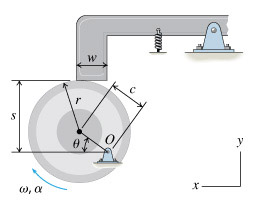Absolute Motion Analysis
Learning Goal:
To
be able to develop an equation relating the linear distance between
moving bodies to the angular position and velocity of the first or
driving body and to use this relationship to derive the function for
absolute velocity and acceleration of the second body.

Part A - Velocity of the lifter
Find the linear velocity of the lifter with respect to point O when the cam has an angular position of
θ = 31 ∘
and is rotating with an angular velocity of
ω = 3.0 rad/s
.
|
|
5.14
|
Part B - Acceleration of the lifter
Find the linear acceleration of the lifter with respect to point O when the angle is
θ = 31 ∘
, the angular velocity is
ω = 3.0 rad/s
, and the angular acceleration is
α = -3.0 rad/s2
.
|
|
-14.4
|
Part C - Range of θ for which the position equation is valid
Find the range of θ for which the position equation s=r+csin(θ) is valid if the width of the lifter is
w = 1.98 in
and its right edge is aligned with O. Give only the range values that lie between 0∘ and 180∘ .
|
|
8.1,90
|
|
No comments:
Post a Comment